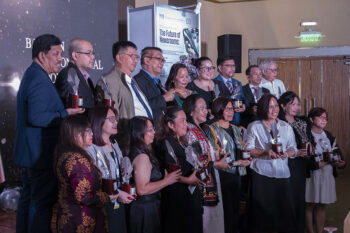DAVAO CITY (MindaNews / 15 Jan) – Mindanao Development Authority (MinDA) assistant secretary Romeo Montenegro said Mindanao’s economy is projected to grow by 7.2% in 2019 pending completion of data for the year, slightly higher compared to the growth attained in 2018 at 7.1%.
 MinDA’s Romeo Montenegro. MindaNews file photo by ANTONIO L. COLINA IV
MinDA’s Romeo Montenegro. MindaNews file photo by ANTONIO L. COLINA IV
Speaking during “Wednesdays at Habi at Kape,” Montenegro said the six Mindanao regions (Zamboanga Peninsula, Northern Mindanao, Davao Region, Soccsksargen, Caraga, and Autonomous Region in Muslim Mindanao) are expected to outperform the overall national gross domestic product estimated at 6% within the government’s revised target of 6 to 6.5%.
Montenegro said the robust performance of Mindanao, which owed its sustained “expansion of services, industry and agri-fisheries sectors,” managed to “demonstrate uninterrupted” growth in nearly two decades since 2001 despite being confronted with major challenges, including power crisis from 2011 to 2015 and a lack of vital infrastructure projects.
From 2010 to 2019, he said the average economic growth of the island was recorded at 6.6% higher than the national average of 6.2% even though it suffered from rotating brownouts due to the deficit in the power supply in the early part of this decade.
“Despite that, the overall Mindanao economy has really shown resiliency. And such robust Mindanao performance showed Mindanao’s resiliency amid adversity, and the island being able to gain from structural resources and sustained development programs,” he added.
Montenegro admitted that more attention must be given towards “regional development outside the economic centers (rural development) and for growth to be more inclusive and sustainable.”
He added more regional inter-linkages and logistics must be rolled out to “attract investments into manufacturing and services, bringing agricultural products, especially the priority commodities, up the value chain to ensure that the high growth rates would be translated to “inclusive growth” in Mindanao.
Montenegro said the government should focus on bringing out of poverty the rural areas where most of the agricultural activities are found.
“If we target to seeing transformation of many areas in Mindanao and improving poverty, there is nowhere else to look at first but in the rural areas,” he added.
Amid the growing industry and services-based sectors, Montenegro said Mindanao “must not lose sight of the fact that key to Mindanao’s sustained economic growth rests largely in the agri sector.”
Montenegro also emphasized the need to promote the industrial growth, complemented with support on “access to quality education and training skills required in the modern economy,” and creation of “more and better jobs” to improve the disposable income of families and “eventually reduce poverty incidence in the long-run.”
He said the government targets to cut poverty level in Mindanao to 20 to 22% at the end of the Duterte administration from the present 35%. (Antonio L. Colina IV / MindaNews)
